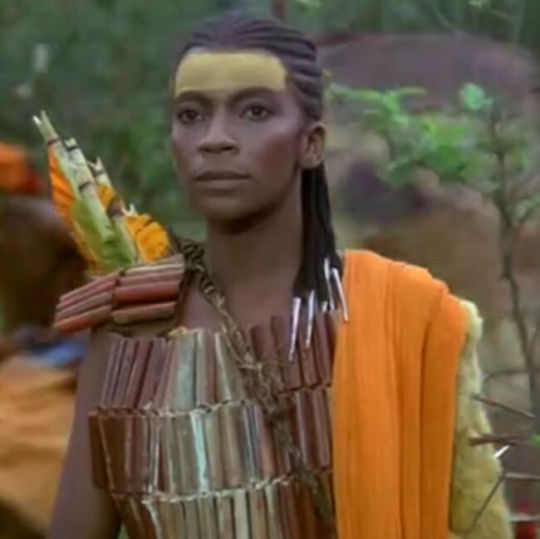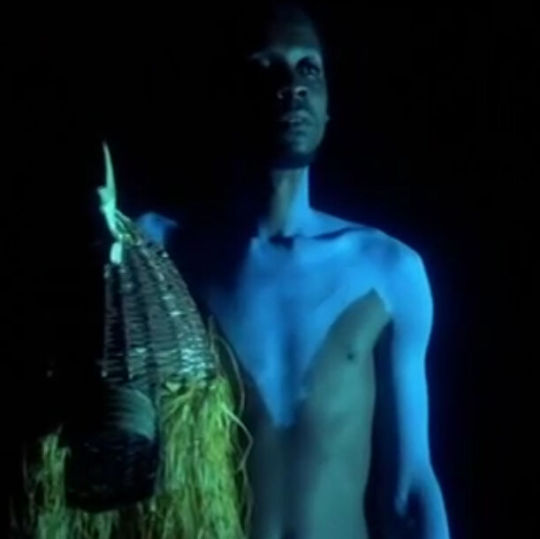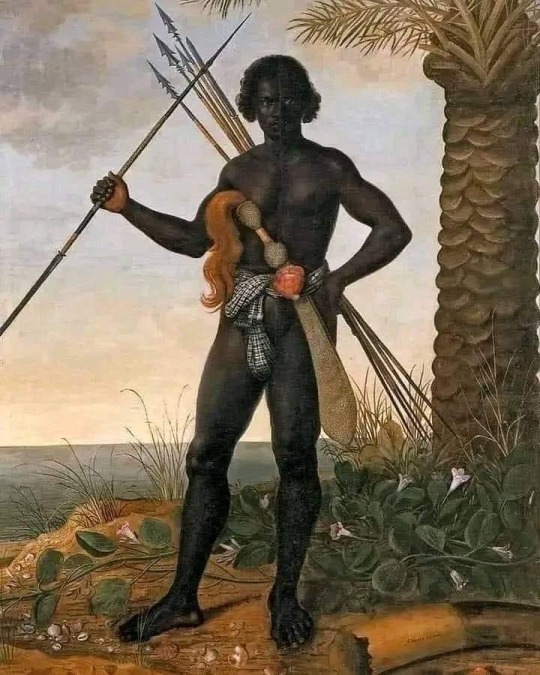#zumbi dos palmares
Text

March in Honor of 300 years of Zumbi dos Palmares, 1995.
Photo: Lazaro Roberto
#Zumbi dos Palmares#Bahia#300 years#1995#Revolutionary#Leader#Legendary#Hero#Palmares#Brazil#History#Culture
18 notes
·
View notes
Text









quilombo, 1984.
#quilombo#filmes nacionais#brazil#zeze motta#tony tornado#antonio pitanga#carlos diegues#zumbi#zumbi dos palmares#ganga zumba#grande otelo#antonio pompeo
11 notes
·
View notes
Text
300 Anos - Alcione - De Tudo Que Eu Gosto
3 notes
·
View notes
Text


Zumbi (1655 – November 20, 1695), also known as Zumbi dos Palmares (Portuguese pronunciation: [zũˈbi dus pɐwˈmaɾis]), was a Brazilian quilombola leader, being one of the pioneers of resistance to slavery of Africans by the Portuguese in colonial Brazil. He was also the last of the kings of the Quilombo dos Palmares, a settlement of Afro-Brazilian people who had liberated themselves from enslavement, in the present-day state of Alagoas, Brazil. Zumbi today is revered in Afro-Brazilian culture as a powerful symbol of resistance against the enslavement of Africans in the colony of Brazil.
25 notes
·
View notes
Text
Elements of the Afro-Mass: Invoking Ancestors
One of the most distinctive moments of the inculturated [Afro-]Mass is the invocation of the martyrs and ancestors. This segment substitutes for the section in the traditional Mass during which the priest prays for the deceased. It is the most explicitly political moment of the Mass. The celebrant begins by asking the congregation to remember those of their ancestors who have died struggling for the freedom of their people. Most of the congregation remains silent, while those who know the list of "martyrs" recite it. The list includes, first and foremost, Zumbi; but also Luiza Mahin, the rebel leader of the Islamic slave uprising in Salvador in 1835; Martin Luther King, Jr.; and Padre Genuino, who was murdered several years ago in the Northeast.
The importance of Zumbi, the leader of a seventeenth-century runaway slave community, is hard to overstate. His image, which is also the most important icon of the secular black movement, can be seen everywhere in association with the inculturated Mass: on the T-shirts of celebrants; on the buttons worn by congregation members; on posters; on the covers of songbooks; in songs. The most popular of all inculturated Mass songs declares: "Hey, Zumbi, Zumbi Ganga my king; you are still in me; you have not died."
The image and name of Zumbi come close to being sacralized by the inculturated Mass. In some celebrations, larger-than-life depictions of Zumbi's (imagined) face are brought to the altar. In others, dirt shipped from Alagoas near where Zumbi's quilombo (slave community) of Palmares was located is distributed and made into the sign of the cross on participants' foreheads. Several lay leaders explicitly said that they regarded Zumbi almost with the same emotion they did Jesus. "As Jesus was our savior," said one woman, "so too was Zumbi." In many celebrations of the Mass, Zumbi's name is repeated more often than Jesus'.
[...]
Most dramatically, the Yoruba names of some of the orixás of candomblé are invoked at various moments, including Oxalá, Oxumaré, and Olorum, with the accompanying claim that these names are the equivalents of Jesus and God.
[...]
While I heard much grumbling about the presence of drums and ginga at Mass, I never heard a complaint about the invocation of the martyrs. I was surprised to hear people who otherwise were critical of the Mass singing the praises of this ritual moment. It was, in their eyes, a statement of the importance of steadfastness and courage, and was a lesson to all Christians to fight for what they believed in.
- John Burdick (Blessed Anastácia: Women, Race, and Popular Christianity in Brazil, pages 59-60, 61, 60-61). Italics original, bolded emphases added.
3 notes
·
View notes
Text
Zumbi dos Palmares: The Afro-Brazilian Leader of Resistance and Freedom
Zumbi dos Palmares, a towering figure in the history of Brazil, was a fearless leader whose legacy continues to inspire generations. Born into the turmoil of colonial Brazil, Zumbi emerged as a symbol of resistance and freedom, leading his people in a valiant struggle against the oppression of slavery.
As the last of the kings of the Quilombo dos Palmares, located in present-day Alagoas, Brazil,…

View On WordPress
#African History#Afro-Brazilian culture#Afro-Brazilian history#Black American History#Brazil#Brazilian quilombola leader#Zumbi dos Palmares
0 notes
Text
FlinkSampa 2023 - 11ª edição
A Festa do Conhecimento, Literatura e Cultura Negra (FlinkSampa) está em sua 11ª edição e será realizada nos dias 18 e 19 de novembro, como parte da Virada da Consciencia. Organizada pela Universidade Zumbi dos Palmares, tem como objetivo valorizar a literatura, descobrir talentos, dar oportunidade aos escritores negros, aos que tratam das questões raciais e aos jovens talentos, por meio de…

View On WordPress
#AFROÉTNICA#CARREFOUR#CONHECIMENTO#CULTURA NEGRA#EMS#FEBRABAN#feira#FLINKSAMOA#GLORIA MARIA#Literatura#livros#UNIVERSIDADE#VIRADADACONSCIENCIA#ZUMBI DOS PALMARES
1 note
·
View note
Text
Por que a consciência é negra e não humana?
Por que a consciência é negra e não humana?
A data pela Consciência Negra cria uma verdadeira revolução no jornalismo e na política. Veículos de comunicação falam de negros, leis anti-racistas são aprovadas, pesquisas sobre “como vive o negro no Brasil?” são publicadas, casos de racismo são lembrados, até que o mês acaba. Basília Rodrigues – CNN
É mais ou menos assim, fala-se de mães em maio; de papai noel em dezembro e da luta racial, o…

View On WordPress
#Agência Senado#casos de racismo#dia da ConscienciaNegra#dia do branco#Estátua de Zumbi dos Palmares#leis anti-racistas#Papai Noel#Pedro França#Por que a consciência é negra e não humana?#preconceito racial#vidasnegrasimportam
2 notes
·
View notes
Text
Hats for Afro-Textured Hair Make Graduation More Inclusive for the Black Population in Brazil
Initiative creates models to be used by Zumbi dos Palmares University and the University of Southern Bahia

Graduation can be a significant moment in a person's life, but it can also become embarrassing and uncomfortable for black people with kinky or curly hair or braids when wearing the capelo. The traditional black hat, common in graduation attire, does not accommodate various types of hair.
Ana Carolina dos Santos, 30, was unable to wear it on the day of her biochemistry degree ceremony in 2015. "It was a very happy day for me, but I didn't feel complete," she says.
Nearly ten years later, after overcoming her frustration, Santos relived that moment, but this time the capelo fit perfectly over her voluminous, unbraided hair. She was part of the #RespeitaMeuCapelo campaign by Vult with the Dendezeiro brand. Four models of the item were designed for different hair types.
"When we understand the symbolic weight of the capelo, that it doesn't work for us, it says that we don't belong in that place," says Igor Hermes, art director of GUT, the agency that developed the project.
Source.
#brazil#brazilian politics#politics#antiracism#education#mod nise da silveira#image description in alt
65 notes
·
View notes
Text

Do you know that Ganga Zumbi, the African Spartacus was born in Kongo in 163O, enslaved and shipped to Brazil to work as a plantation slave? He managed to escape, raised an army of eslaved Africans and founded his own kingdom of Palmares, with a palace and court.
48 notes
·
View notes
Text
list of brazilians that appeared on the screen during madonna’s celebration tour concert in rio
paulo freire
erika hilton
cazuza
renato russo
raoni metuktire
zumbi dos palmares
abdias do nascimento
leon hirszman
mano brown
elza soares
marielle franco
gilberto gil
marta
marina silva
sueli carneiro
caetano veloso
pelé
sebastião salgado
daniela mercury
maria bethânia
txai suruí
caio fernando abreu
bruno pereira
mauro gonçalves (zacarias)
24 notes
·
View notes
Text
"This November 20th, Black Consciousness Day is celebrated, in honor of the leader of the largest quilombo fighting to end slavery, Zumbi dos Palmares. To celebrate these data, and remember the importance of black people in the construction of Brazil, be it cultural, social or economic"

"As long as the philosophy that there is an 🕊 inferior and a superior race prevails, the world will be permanently at war."🕊
51 notes
·
View notes
Text
I saw a deep dive on that conspiracy whacko who murdered her kids. And all I can think of is how does a wise woman fear an eclipse? Nature is your ally. Astrology is study of the stars and planetary bodies as gods within us.
Imagine if ancestral powerful magicians like Harriet Tubman and Zumbi dos Palmares were as lack minded and weak as todays alleged magical folk smh.
6 notes
·
View notes
Text
Não é sobre a beleza, mas a luta por trás
“Nossa, que serviço de preto!’, “Seu cabelo é tão ruim, por que não alisa?”
Infelizmente, essas frases são muito comuns e mostram como o racismo está enraizado na sociedade. Mas nem sempre foi assim. Até onde a história conta, na Grécia Antiga não havia racismo, apesar de (lamentável, Grécia) existirem escravizados, e essa condição imposta nada tinha a ver com a sua cor, pois os escravos eram prisioneiros de guerra ou pessoas condenadas por crimes. Então, como isso começou?
Avançando no tempo, no século XV, começaram as expansões marítimas, as Américas foram descobertas e se iniciou o massacre de povos indígenas e a escravização do continente africano, dando origem a esse preconceito com povos negros. E o resto da história todo mundo conhece. Quando falamos de viagens e pontos turísticos, a história e a presença da cultura afro é muito forte em diversos aspectos, especialmente no Brasil. Por isso, vou mostrar três cidades com forte influência das nossas origens.
Salvador, Bahia
Uma das capitais mais vibrantes, que expressa criatividade e originalidade, Salvador celebra sua cultura de forma única. Para quem gosta de curtir o carnaval, sem dúvida esse é o melhor lugar para curtir os bloquinhos e se divertir ao máximo. O principal gênero musical, o samba reggae, que une os ritmos mais presentes no Brasil e na Jamaica, atrai quase um milhão de pessoas por ano.
Mas não é só o carnaval que torna essa cidade tão ilustre não. O bairro Pelourinho costuma ser um palco de manifestações, ateliês e galerias, e tem diversos museus que nos levam a passeios históricos, como o Museu Nacional da Cultura Afro Brasileiro e a Cidade da Música da Bahia.
Serra da Barriga, Alagoas
Um dos mais importantes símbolos da luta contra a escravidão no Brasil foi sem dúvidas Zumbi dos Palmares, que até hoje é homenageado, tendo a data da sua morte (20 de novembro) como Dia da Consciência Negra. E é na Serra da Barriga que está o Quilombo dos Palmares, que foi liderado por ele durante 16 anos e era refúgio de mais de 20 mil negros escravizados na época.
Atualmente, o local é reconhecido pelo Instituto do Patrimônio Histórico e Artístico Nacional como um parque nacional. Lá a imersão é completa e existem pontos de áudio e textos para entender a realidade daquelas pessoas, sem falar que o próprio ambiente permite conhecer melhor a luta pela resistência negra no nosso país.
São Luís, Maranhão
Na música e nos museus, a identidade negra pode ser vista e apreciada de diversas formas, e também na dança acha seu espaço no Tambor de Crioula. Essa é uma dança típica do estado maranhense, de origem africana, que pode ser apreciada em quase todos os lugares da cidade durante o ano todo.
As paradas obrigatórias de quem passa pela cidade são o Museu Cafuá das Mercês, a Casa do Tambor de Crioula, o Mercado Casa das Tulhas e, claro, o centro histórico, todos pontos turísticos que preservam a cultura dessa cidade maravilhosa.
Espero que vocês tenham a oportunidade de ir nessas cidades incríveis que, com certeza, já estão na minha lista de viagens dos sonhos. Por hoje é isso, fica a reflexão da valorização da identidade negra no nosso país e semana que vem eu volto com mais lugares para dar um rolê.
11 notes
·
View notes
Note
Infodump time!!
Ok SO I have been doing martial arts for more or less half a year. It's so much fun! But it's not the most commonly known kinds of martial arts, but a Brazilian kind of fight style called capoeira.
Capoeira was developed by enslaved African people in the sixteenth century. Brazil received almost half of all the African people shipped to the American continent. Because of that, most of our population is black ( around 52% if I'm not wrong. ) We also have way more mixed people than most other countries, according to Gilberto Freyre because "there was no oficial policy of extermination and segregation of black people" which is total bulshit! Brazil is still a very, very racist country, unfortunately. Our police officers are some of the most violent in the world and constantly murdering black people in communities in order to 'solve drug problems' and stuff like that.
Anyways, capoeira was invented as a form of resistance. It is not like most other fight styles because it mixes music, dance, and fight moves. It is like that because when it was invented, the enslaved people had to pretend they were dancing or celebrating. If the colonizers knew they were training, they would've broken it off and punished them.
Nevertheless, in Brazil we had things called Quilombos. Those were seld suficiente communities formed by black people who had scaped their farms, and many times they also had indigenous people and even free people who were poor and couldn't survive by themselves. The biggest of these communities was the Quilombo de Palmares, led by a guy called zumbi, and his partner Dandara ( both very brave people who fought until they could no longer and died for their cause. I find Dandara to be an especially strong person. ) Anyways, what matters to us here is that the Quilombo de Palmares was defended for more than a century, many times using capoeira. The colonizers had resources, firearms, armies. Still, they lost so many times they offered to compromise. You know what's that ? Entitled people compromising ? Well, half compromising. They said they would leave the quilombo alone if they stopped accepting new slaved people who had run off. Zombie wanted to take the deal, but Dandara refused. It was all of them, or none of them. He was killed by the colonizers and his body was hang up, and she ended up committing suicide in order to not be captured.
Anyways I LOVE capoeira. I have training 2 times a week, I have awesome friends there and the teachers are super helpful, every time we play one on one is super fun and the music is awesome and the traditional instruments are super duper cool!!! I'm always learning something new I just love it so much. I love clapping along the music until my hands hurt and falling and tripping when I try something bold, I love singing along, love knowing I'm improving, I love kicking and dodging until my whole body's sore. I love the community. I love capoeira.
Wow. It’s so cool that you took the time to learn the skill AND all of its rich and important history! What’s you favorite thing you’ve learned throughout the training?
#robin#ask#but actually#that’s so interesting#I didn’t know you were into martial arts this changes my gay everything
8 notes
·
View notes
Text

Olá novamente, pessoal!
Como temos uma data super importante inclusa nesse mês, o Dia da Consciência Negra (20/11). Estou passando por aqui para recomendar para vocês um filme incrível, que aborda o tema! E dessa vez, para os noveleiros que amam a Regina Casé!
Dia 20 de novembro, é celebrado o Dia Nacional da Consciência Negra. A data foi dada em homenagem ao líder quilombola Zumbi dos Palmares, um dos pioneiros da luta contra a escravidão negra no Brasil.
Em um cenário marcado pela diversidade cultural e pela busca incessante por igualdade, "Que horas ela volta?" surge como uma obra impactante, centrada no tema crucial da luta negra.
"A pernambucana Val (Regina Casé) se mudou para São Paulo a fim de dar melhores condições de vida para sua filha Jéssica. Com muito receio, ela deixou a menina no interior de Pernambuco para ser babá de Fabinho, morando integralmente na casa de seus patrões. Treze anos depois, quando o menino (Michel Joelsas) vai prestar vestibular, Jéssica (Camila Márdila) lhe telefona, pedindo ajuda para ir à São Paulo, no intuito de prestar a mesma prova. Os chefes de Val recebem a menina de braços abertos, só que quando ela deixa de seguir certo protocolo, circulando livremente, como não deveria, a situação se complica" — Sinopse do filme pelo site AdoroCinema.
Dirigido por Anna Muylaert, é uma obra brasileira!
“O maior privilégio é o de nem mesmo precisar pensar nos seus privilégios”. Esta frase, referindo-se às pessoas brancas, foi dita durante um debate histórico sobre racismo, ocorrido em 2015, no Itaú Cultural, por um jovem negro da periferia de São Paulo que estava na plateia.
Portanto, recomendo completamente o filme para que todos entendam sobre mais profundamente sobre o assunto. E, sendo uma obra brasileira, temos atrizes e atores incríveis!
Obrigada, até a próxima!
At.te,
Gi.
3 notes
·
View notes